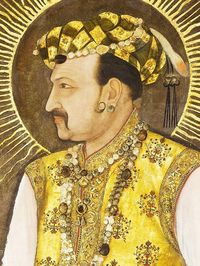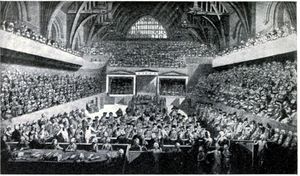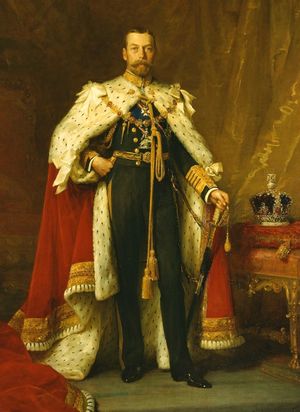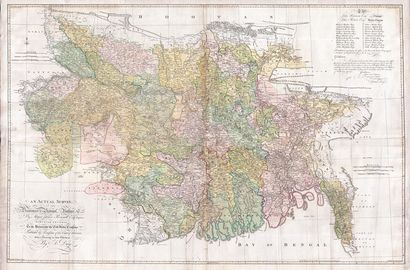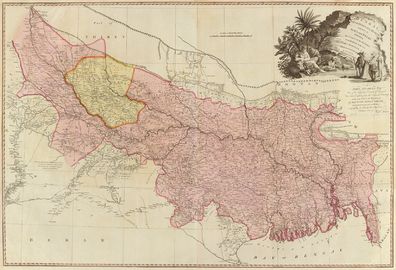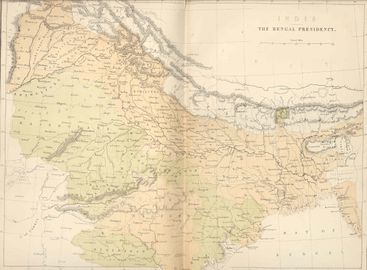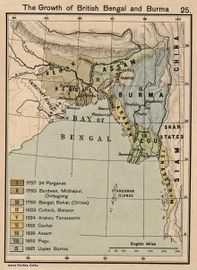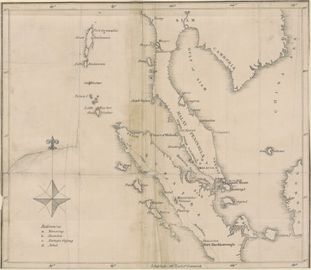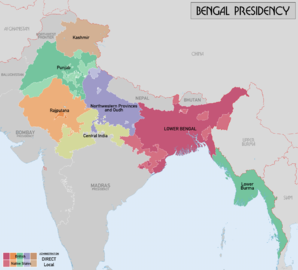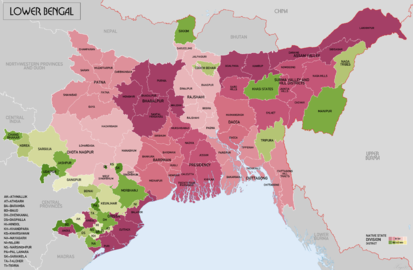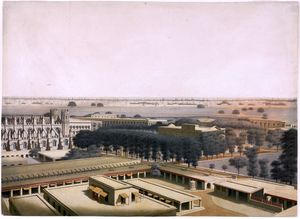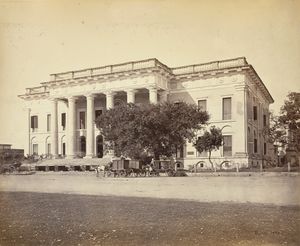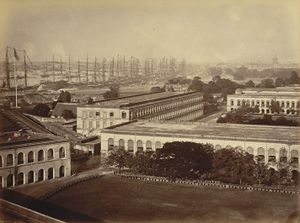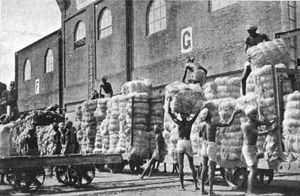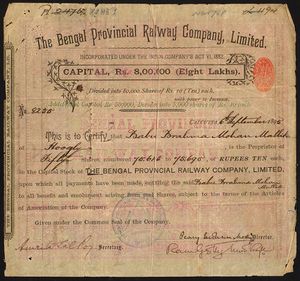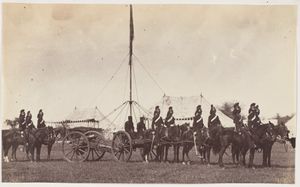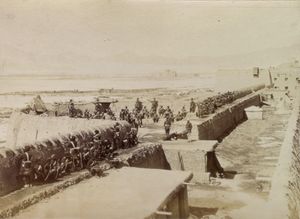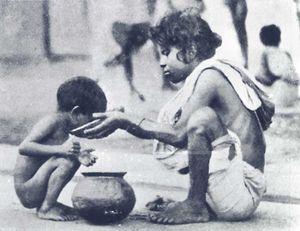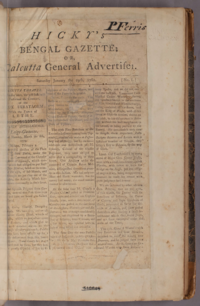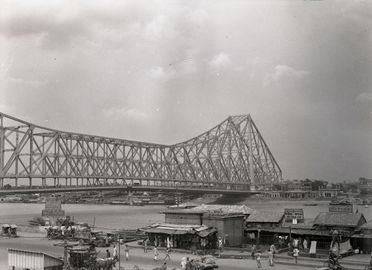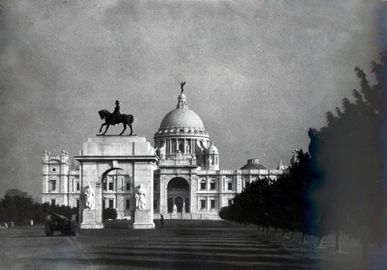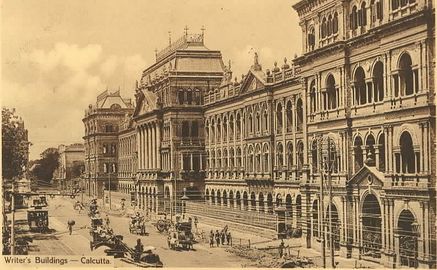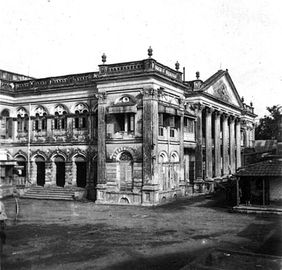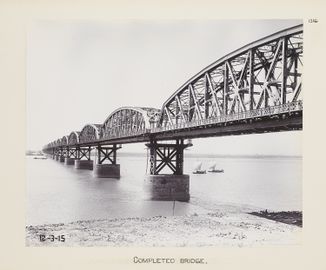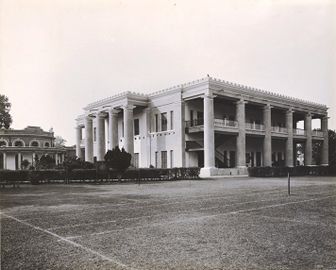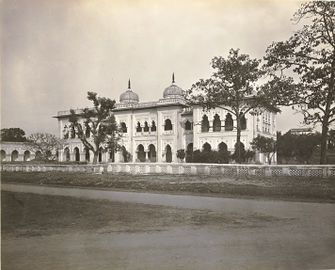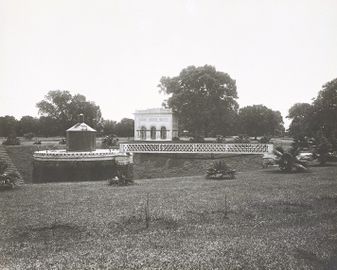رئاسة البنغال
رئاسة فورت وليام Bengal | |
|---|---|
| 1612–1947 | |
  Left: Flag of the East India Company (1612-1858) Right: Union Jack (1858-1947) | |
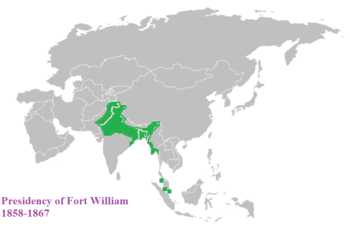 خريطة تبين نطاق رئاسة البنغال في ع1860 | |
| الوضع | رئاسات ومقاطعات الهند البريطانية |
| العاصمة | كلكتا |
| اللغات المشتركة | الإنگليزية (الرسمية) بنغالي، هندوستاني |
| التشريع | Legislature of Bengal |
| المجلس التشريعي البنغالي (1862-1947) | |
| الجمعية التشريعية البنغالية (1935-1947) | |
| الحقبة التاريخية | العصر الاستعماري |
• إذن المغل بالتجارة في صوبة البنغال | 1612 |
| 1947 | |
| العملة | روپيه هندية، جنيه استرليني |
| اليوم جزء من | |
رئاسة البنغال Bengal Presidency، رسمياً رئاسة فورت وليام ولاحقاً مقاطعة البنغال، كانت تقسيماً في الامبراطورية البريطانية في الهند. وفي أوج توسعها الإقليمي، شملت أجزاء واسعة مما هو الآن جنوب آسيا وجنوب شرق آسيا. البنغال نفسها شملت المنطقة العرقية-اللغوية البنغال (بنگلادش الحالية وولاية البنغال الغربية الهندية). كلكتا، المدينة التي نمت حول فورت وليام، كانت عاصمة رئاسة البنغال. ولسنين عديدة، كان حاكم البنغال في نفس الوقت هو نائب الملك على الهند وكانت كلكتا عاصمة الهند الفعلية حتى مطلع القرن العشرين.
برزت رئاسة البنغال من بين نقاط التجارة التي تأسست في بنغال المغل في عهد الامبراطور جهانگير في 1612. تنافست شركة الهند الشرقية (HEIC)، وهي شركة احتكار بريطانية لها ميثاق ملكي، مع شركات أوروبية أخرى لكسب النفوذ في البنغال. فبعد الإطاحة الحاسمة بنواب البنغال عام 1757 ومعركة بوكسار في عام 1765، وسعت HEIC سيطرتها على جزء كبير من شبه القارة الهندية. وكان هذا بمثابة بداية حكم الشركة في الهند، عندما ظهر HEIC كأقوى قوة عسكرية في شبه القارة الهندية. سحب البرلمان البريطاني تدريجياً احتكار HEIC. وبحلول خمسينيات القرن التاسع عشر، كافحت HEIC بالموارد المالية.[1] بعد التمرد الهندي عام 1857، تولت الحكومة البريطانية الإدارة المباشرة للهند. وأعيد تنظيم رئاسة البنغال. في أوائل القرن العشرين، برزت البنغال باعتبارها مرتعاً لحركة استقلال الهند، وكذلك مركز عصر النهضة البنغالية.
كانت البنغال المحور الاقتصادي والثقافي والتعليمي للحكم البريطاني. خلال فترة التصنيع الأولي، ساهمت البنغال بشكل كبير في الثورة الصناعية في بريطانيا، على الرغم من تجاوزها قريباً من قبل مملكة ميسور التي يحكمها طيپو سلطان باعتبارها القوة الاقتصادية المهيمنة لجنوب آسيا.[2]عندما أعيد تنظيم البنغال، تم فصل پنانگ وسنغافورة وملاكا إلى مستوطنات المضائق في عام 1867.[3]وقد أصبحت بورما البريطانية مقاطعة هندية ولاحقاً مستعمرة التاج في حد ذاتها. وتمت إعادة تنظيم المناطق الغربية، بما في ذلك المقاطعات المتنازل عنها والمهزومة و الپنجاب. وأصبحت المناطق الشمالية الشرقية من مستعمرة أسام. كما أدى تقسيم الهند البريطانية في عام 1947 إلى تقسيم البنغال على أسس دينية.
التاريخ
خلفية
في عام 1599، تم منح امتياز ملكي من قبل إليزابث الأولى من إنگلترة للسماح بإنشاء شركة تجارية في لندن لأغراض التجارة مع جزر الهند الشرقية. تم وضع حوكمة الشركة في أيدي المحافظ ومجلس الإدارة المكون من 24 عضواً. أصبحت الشركة معروفة باسم شركة الهند الشرقية المحترمة (HEIC). لقد ارتفع ليشكل نصف التجارة العالمية.[بحاجة لمصدر] منحت الشركة احتكار التجارة البريطانية في المحيط الهندي.[1]
التغييرات الادارية والتسوية الدائمة
Under Warren Hastings, the consolidation of British imperial rule over Bengal was solidified, with the conversion of a trade area into an occupied territory under a military-civil government, while the formation of a regularised system of legislation was brought in under John Shore. Acting through Lord Cornwallis, then Governor-General, he ascertained and defined the rights of the landholders over the soil. These landholders under the previous system had started, for the most part, as collectors of the revenues, and gradually acquired certain prescriptive rights as quasi-proprietors of the estates entrusted to them by the government. In 1793 Lord Cornwallis declared their rights perpetual, and gave over the land of Bengal to the previous quasi-proprietors or zamindars, on condition of the payment of a fixed land tax. This piece of legislation is known as the Permanent Settlement of the Land Revenue. It was designed to "introduce" ideas of property rights to India, and stimulate a market in land. The former aim misunderstood the nature of landholding in India, and the latter was an abject failure.
The Cornwallis Code, while defining the rights of the proprietors, failed to give adequate recognition to the rights of the under-tenants and the cultivators. This remained a serious problem for the duration of British Rule, as throughout the Bengal Presidency ryots (peasants) found themselves oppressed by rack-renting landlords, who knew that every rupee they could squeeze from their tenants over and above the fixed revenue demanded from the Government represented pure profit. Furthermore, the Permanent Settlement took no account of inflation, meaning that the value of the revenue to Government declined year by year, whilst the heavy burden on the peasantry grew no less. This was compounded in the early 19th century by compulsory schemes for the cultivation of opium and indigo, the former by the state, and the latter by British planters. Peasants were forced to grow a certain area of these crops, which were then purchased at below market rates for export. This added greatly to rural poverty.
So unsuccessful was the Permanent Settlement that it was not introduced in the North-Western Provinces (taken from the Marathas during the campaigns of Lord Lake and Arthur Wellesley) after 1831, in Punjab after its conquest in 1849, or in Oudh which was annexed in 1856. These regions were nominally part of the Bengal Presidency, but remained administratively distinct. The area of the Presidency under direct administration was sometimes referred to as Lower Bengal to distinguish it from the Presidency as a whole. Officially Punjab, Agra and Allahabad had Lieutenant-Governors subject to the authority of the Governor of Bengal in Calcutta, but in practice they were more or less independent. The only all-Presidency institutions which remained were the Bengal Army and the Civil Service. The Bengal Army was finally amalgamated into the new British-Indian Army in 1904–5, after a lengthy struggle over its reform between Lord Kitchener, the Commander-in-Chief, and Lord Curzon, the Viceroy.
مستوطنات المضائق
In 1830, the British Straits Settlements on the coast of the Malacca Straits was made a residency of the Presidency of Bengal in Calcutta. The area included the erstwhile Prince of Wales Island and Province Wellesley, as well as the ports of Malacca and Singapore.[3]
Under the administration of the East India Company, the Settlements were used as penal settlements for Indian civilian and military prisoners,[4] earning them the title of the "Botany Bays of India".[5] The years 1852 and 1853 saw minor uprisings by convicts in Singapore and Penang.[6] Upset with East India Company rule, in 1857 the European population of the Settlements sent a petition to the British Parliament[7] asking for direct rule.
تقسيم البنغال 1905
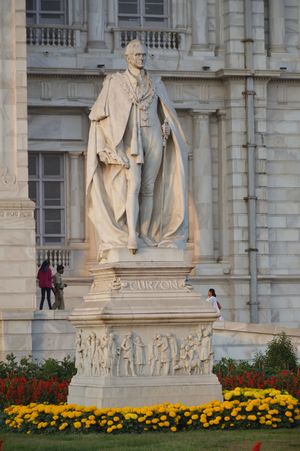
اعادة تنظيم البنغال 1912
At the Delhi Durbar on 12 December 1911, King George V announced the transfer of the seat of the Government of India from Calcutta to Delhi, the reunification of the five predominantly Bengali-speaking divisions into a Presidency (or province) of Bengal under a Governor, the creation of a new province of Bihar and Orissa under a lieutenant-governor, and that Assam Province would be reconstituted under a chief commissioner. On 21 March 1912 Thomas Gibson-Carmichael was appointed Governor of Bengal; prior to that date the Governor-General of India had also served as the governor of Bengal Presidency. On 22 March the provinces of Bengal, Bihar and Orissa and Assam were constituted.[8]
The Government of India Act 1919 increased the number of nominated and elected members of the legislative council from 50 to 125, and the franchise was expanded.[9] Bihar and Orissa became separate provinces in 1936. Bengal remained in its 1912 boundaries until Independence in 1947, when it was again partitioned between the dominions of India and Pakistan.
تقسيم البنغال 1947
The British government considered the possibility of an independent, undivided Bengal. The partition was opposed by the last Governor of Bengal Sir Frederick Burrows.[10] On May 8, 1947, Viceroy Earl Mountbatten cabled the British government with a partition plan that made an exception for Bengal. It was the only province that would be allowed to remain independent should it choose to do so. On May 23, the British Cabinet meeting also hoped that Bengal would remain united. British Prime Minister Clement Attlee informed the US Ambassador to the United Kingdom on 2 June 1947 that there was a"distinct possibility Bengal might decide against partition and against joining either Hindustan or Pakistan".[11] On 6 June 1947, the Sylhet referendum gave a mandate for Sylhet Division to be re-united into Bengal. However, Hindu nationalist leaders in West Bengal and conservative East Bengali Muslim leaders were against the prospect.
On 20 June 1947, the Bengal Legislative Assembly met to vote on partition plans. At the preliminary joint session, the assembly decided by 120 votes to 90 that it should remain united if it joined the new Constituent Assembly of Pakistan. Later, a separate meeting of legislators from West Bengal decided by 58 votes to 21 that the province should be partitioned and that West Bengal should join the existing Constituent Assembly of India. In another separate meeting of legislators from East Bengal, it was decided by 106 votes to 35 that the province should not be partitioned and 107 votes to 34 that East Bengal should join Pakistan in the event of partition.[12] There was no vote held on the proposal for an independent United Bengal.
الجغرافيا
At its greatest extent, the Bengal Presidency stretched from the Khyber Pass in the northwest to Lower Burma and the Malacca Straits in the Far East. Its principal maritime gateway was the Bay of Bengal. The following maps illustrate its territorial evolution.
- خرائط رئاسة البنغال
Map showing northern regions of the Presidency in 1858, including princely states of Kashmir, Rajputana Agency, and the Punjab
Bengal Province in 1931 and adjoining princely states of Hill Tippera and Cooch Behar State
الحكم
المجلس التشريعي البنغالي (1862-1947)
The British government began to appoint legislative councils under the Indian Councils Act 1861. تأسس المجلس التشريعي البنغالي في 1862. It was one of the largest and most important legislative councils in British India. Over the years, the council's powers were gradually expanded from an advisory role to debating government policies and enacting legislation. Under the Government of India Act, 1935, the council became the upper chamber لمجلس التشريع النغالي.
الحكم الثنائي (1920–37)
إصلاحات مونتاگو-تشلمسفورد في الهند البريطانية في 1919، أصبحت قانوناً في 1921، وسّعت المجلس التشريعي البنغالي إلى 140 عضو ليضم المزيد من الأعضاء الهنود المنتخبين. أدخلت الإصلاحات أيضاً مبدأ الحكم الثنائي، حيث تم نقل مسئوليات معينة مثل الزراعة والصحة والتعليم والحكم المحلي إلى وزراء منتخبين. ومع ذلك ، تم الاحتفاظ بالمناصب الهامة مثل المالية والشرطة والري لأعضاء المجلس التنفيذي للحاكم. بعض الوزراء البارزين هم سورندراناث بانرجي (الحكم الذاتي المحلي والصحة العامة 1921-1923)، السير پروڤاش تشوندر ميتر (التعليم 1921–1924، الحكم الذاتي المحلي والصحة العامة، الزراعة، الأشغال العامة 1927–1928)، نواب سيد نواب علي شودري (الزراعة والأشغال العامة) وأبو القاسم فضل الحق (التعليم 1924). بوپندرا ناث بوز والسير عبد الرحيم كانوا أعضاء تنفيذيين في مجلس الحاكم.[13]
المجلس التشريعي للبنغال (1935-1947)
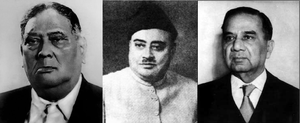
الولايات الأميرية
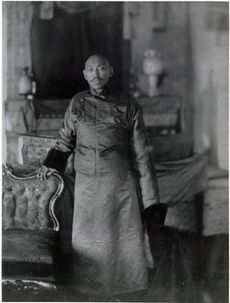
Princely states were autonomous principalities under the suzerainty of the British Crown in India. Initially, the Bengal Presidency managed the British government's relations with most princely states in the northern subcontinent, extending from Jammu and Kashmir in the north to Manipur in the northeast. An Agency was often formed to be the liaison between the government and the princely states. The largest of these agencies under Bengal once included the Rajputana Agency. Other agencies covered the Chota Nagpur Tributary States and the Orissa Tributary States. Agents were also appointed to deal with tribal chiefs, such as the three tribal kings in the Chittagong Hill Tracts. At the time of the partition of India in 1947, the jurisdiction of the Bengal States Agency included Cooch Behar State and Hill Tipperah.
Himalayan kingdoms
Bengal was strategically important for the Himalayan regions of Nepal, Tibet, Bhutan and Sikkim. The Anglo-Nepalese War between the East India Company and the Kingdom of Nepal was concluded with the Treaty of Sugauli, which ended Gorkha territorial expansion. The Treaty of Titalia was signed in 1817 between the HEIC and the Kingdom of Sikkim to establish British hegemony over Sikkim. The Bhutan War in the 1860s saw the Kingdom of Bhutan lose control of the Bengal Duars to the British. The British Expedition to Tibet took place between 1903 and 1904. It resulted in the Treaty of Lhasa which acknowledged Qing China's supremacy over Tibet.
Foreign relations
The United States of America began sending envoys to Fort William in the 18th-century. President George Washington nominated Benjamin Joy as the first Consul to Fort William on 19 November 1792. The nomination was supported by the erstwhile Secretary of State Thomas Jefferson and approved by the U. S. Senate on 21 November 1792. Benjamin Joy reached Calcutta in 1794. The HEIC did not recognize Joy as an official consul but allowed him to be a Commercial Agent.[14] The American Consulate General was established during formal British rule. A consular agency for Chittagong was created in the 1860s. Many other countries also set up consulates in Calcutta.
التعليم

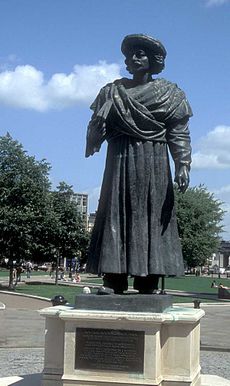
الاقتصاد
البنية التحتية والنقل
السكك الحديدية
الطيران
العسكر
المجاعة
Famine struck Bengal several times during British rule. The Great Bengal famine of 1770 endured till 1773. The East India Company was heavily criticized for neglecting the food security the population. The repeated bouts of famine in India, coupled with other abuses against the population, caused the British Parliament to gradually remove the monopoly of the East India Company, curtail the Company's powers and eventually replace it with crown rule. Warren Hastings, who served as Governor of Bengal from 1772 to 1774, was censured by Westminster for the abuses of the Company. Ironically, Hastings had set about to reform the Company's practices and was later acquitted of any wrongdoing. During the trial of Hastings, however, Edmund Burke delivered a scathing indictment of malpractice by the Company, condemning it for "injustice and treachery against the faith of nations". Burke stated "With various instances of extortion and other deeds of maladministration....With impoverishing and depopulating the whole country.....with a wanton and unjust, pernicious, exercise of his powers.....in overturning the ancient establishments of the country......With cruelties unheard of and devastations almost without name......Crimes which have their rise in the wicked dispositions of men- in avarice, rapacity, pride, cruelty, malignity, haughtiness, insolence, ferocity, treachery, cruelty, malignity of temper - in short, nothing that does not argue a total extinction of all moral principle, that does not manifest an inveterate blackness of heart, a heart blackened to the very blackest, a heart corrupted, gangrened to the core.....We have brought before you the head (Hastings)....one in whom all the frauds, all the peculations, all the violence, all the tyranny in India are embodied".[15]
The Bengal Presidency endured a vast famine between 1873 and 1874. The Bengal famine of 1943 killed an estimated 3 million people during World War II. People died of starvation, malaria, or other diseases aggravated by malnutrition, population displacement, and lack of healthcare. Britain's wartime Prime Minister Winston Churchill is blamed by critics in India (i.e. Amartya Sen and Shashi Tharoor) for causing the famine. When British civil servants sent letters to London regarding the famine situation, Churchill once responded by saying "Why hasn't Gandhi died yet?".[16][17] Churchill's defenders, however, argue that it is an exaggeration to blame him for the wartime hunger crisis. Arthur Herman notes "The idea that Churchill was in any way ‘responsible’ or ‘caused’ the Bengal famine is of course absurd. The real cause was the fall of Burma to the Japanese, which cut off India's main supply of rice imports when domestic sources fell short, which they did in Eastern Bengal after a devastating cyclone in mid-October 1942".[18]
الثقافة
التطور الأدبي
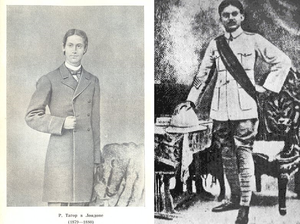
الإعلام
الفنون المرئية
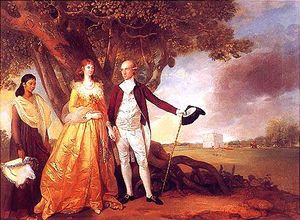
European painters produced numerous works in Bengal since the 18th-century. European photographers also worked in the region. The modernist Bengal school of painting evolved in the province. European sculptures were widely imported by wealthy Zamindars. In the 1940s, Zainul Abedin emerged as a modernist painter depicting poverty and the Bengal famine.
السينما
The Royal Bioscope Company began producing Bengali cinema in 1898, producing scenes from the stage productions of a number of popular shows[19] at the Crown Theatre in Dacca and the Star Theater, Minerva Theater, and Classic Theater in Calcutta.
نهضة البنغال
The Bengal renaissance refers to social reform movements during the 19th and early 20th centuries in the region of Bengal in undivided India during the period of British rule. Historian Nitish Sengupta describes it as having started with reformer and humanitarian Raja Ram Mohan Roy (1775–1833), and ended with Asia's first Nobel laureate Rabindranath Tagore (1861–1941).[20] This flowering of religious and social reformers, scholars, and writers is described by historian David Kopf as "one of the most creative periods in Indian history".[21] These movements were most prevalent in Bengali Hindu society, such as through the Brahmo Samaj. There was a growing cultural awakening in Bengali Muslim society, including the emergence of Mir Mosharraf Hossain as the first Muslim novelist of Bengal; Kazi Nazrul Islam as a celebrated poet who merged Bengali and Hindustani influences; Begum Rokeya and Nawab Faizunnesa as feminist educators; Kaykobad as an epic poet; and members of the Freedom of Intellect Movement.
Bengal played a major role in the Indian independence movement and the Pakistan movement. The earliest organized anti-colonial groups appeared in Bengal. The region produced many of the subcontinent's political leaders during the early 20th century. Political parties and rebel groups were formed across the region.
العمارة
Civic architecture began following European styles after the advent of the East India Company's authority. The Indo-Saracenic style, merging Gothic and Indo-Islamic architecture, was started by British architects in the late 19th-century. While cities such as Calcutta and Dacca featured more civic architecture, country houses were built in many towns and villages across Bengal. Art deco influences began in the 1930s. Wealthy Bengali families (especially zamindar estates) employed European firms to design houses and palaces.
- Architecture in British Bengal
Howrah Bridge in 1945
Hardinge Bridge, 1915
Dacca College, 1904
Nawab's Shahbagh Garden, 1904
انظر أيضاً
المراجع
- ^ أ ب William Dalrymple (10 September 2019). The Anarchy: The Relentless Rise of the East India Company. Bloomsbury Publishing. ISBN 978-1-4088-6440-1.
- ^ Parthasarathi, Prasannan (2011), Why Europe Grew Rich and Asia Did Not: Global Economic Divergence, 1600–1850, Cambridge University Press, ISBN 978-1-139-49889-0, https://books.google.com/books?id=1_YEcvo-jqcC
- ^ أ ب "The Straits Settlements becomes a residency - Singapore History". Eresources.nlb.gov.sg. Retrieved 2020-03-30.
- ^ Anderson, C (2007) The Indian Uprising of 1857–8: prisons, prisoners, and rebellion, Anthem Press. P14
- ^ S. Nicholas and P. R. Shergold, "Transportation as Global Migration", in S. Nicholas (ed.) (1988) Convict Workers: Reinterpreting Australia's Past, Cambridge: Cambridge University Press, Cambridge
- ^ Turnbull, C. M. (1970). "Convicts in the Straits Settlements 1826-1867". Journal of the Malaysian Branch of the Royal Asiatic Society. 43 (1 (217)): 87–103. JSTOR 41492016.
- ^ Petition reprinted in Straits Times, 13 October 1857
- ^ Ilbert, Sir Courtenay Peregrine (1922). The Government of India, Third Edition, revised and updated. Clarendon Press. pp. 117–118.
- ^ Ilbert, Sir Courtenay Peregrine (1922). The Government of India, Third Edition, revised and updated. Clarendon Press. p. 129.
- ^ The Transfer of Power in India By V.P. Menon
- ^ Shoaib Daniyal (2019-01-06). "Why did British prime minister Attlee think Bengal was going to be an independent country in 1947?". Scroll.in. Retrieved 2020-03-30.
- ^ Mukherjee, Soumyendra Nath (1987). Sir William Jones: A Study in Eighteenth-century British Attitudes to India. Cambridge University Press. Page 203. ISBN 978-0-86131-581-9.
- ^ The Working Of Dyarchy In India 1919 1928. D.B.Taraporevala Sons And Company.
- ^ https://in.usembassy.gov/embassy-consulates/kolkata/
- ^ William Dalrymple (10 September 2019). The Anarchy: The Relentless Rise of the East India Company. Bloomsbury Publishing. p. 308. ISBN 978-1-4088-6440-1.
- ^ Maya Oppenheim @mayaoppenheim (2017-03-21). "'Winston Churchill is no better than Adolf Hitler,' says Indian politician Dr Shashi Tharoor". The Independent. Retrieved 2020-03-30.
- ^ Michael Safi in Delhi. "Churchill's policies contributed to 1943 Bengal famine – study | World news". The Guardian. Retrieved 2020-03-30.
- ^ "The Bengali Famine - The International Churchill Society". Winstonchurchill.org. Retrieved 2020-03-30.
- ^ "Who's Who of Victorian Cinema - Hiralal Sen". victorian-cinema.net.
- ^ Nitish Sengupta (2001). History of the Bengali-speaking People. UBS Publishers' Distributors. p. 211. ISBN 978-81-7476-355-6.
The Bengal Renaissance can be said to have started with Raja Ram Mohan Roy (1775-1833) and ended with Rabindranath Tagore (1861-1941).
- ^ Kopf, David (December 1994). "Amiya P. Sen. Hindu Revivalism in Bengal 1872". American Historical Review (Book review). 99 (5): 1741–1742. JSTOR 2168519.
أعمال مذكورة
This article incorporates text from a publication now in the public domain: Chisholm, Hugh, ed. (1911). . دائرة المعارف البريطانية (eleventh ed.). Cambridge University Press. {{cite encyclopedia}}: Cite has empty unknown parameter: |coauthors= (help)
- C. A. Bayly Indian Society and the Making of the British Empire (Cambridge) 1988
- C. E. Buckland Bengal under the Lieutenant-Governors (London) 1901
- Sir James Bourdillon, The Partition of Bengal (London: Society of Arts) 1905
- Susil Chaudhury From Prosperity to Decline. Eighteenth Century Bengal (Delhi) 1995
- Sir William Wilson Hunter, Annals of Rural Bengal (London) 1868, and Odisha (London) 1872
- P.J. Marshall Bengal, the British Bridgehead 1740–1828 (Cambridge) 1987
- Ray, Indrajit Bengal Industries and the British Industrial Revolution (1757–1857) (Routledge) 2011
- John R. McLane Land and Local Kingship in eighteenth-century Bengal (Cambridge) 1993
وصلات خارجية
- Pages using gadget WikiMiniAtlas
- Pages using infobox country or infobox former country with the flag caption or type parameters
- Pages using infobox country or infobox former country with the symbol caption or type parameters
- Articles with unsourced statements from February 2022
- Articles with hatnote templates targeting a nonexistent page
- مقالات المعرفة المحتوية على معلومات من دائرة المعارف البريطانية طبعة 1911
- Wikipedia articles incorporating text from the 1911 Encyclopædia Britannica
- Coordinates on Wikidata
- Bengal Presidency
- History of Assam
- History of Bangladesh
- History of Bengal
- History of Bihar
- History of Kolkata
- History of Odisha
- History of West Bengal
- مناطق هندية تاريخية
- 1765 establishments in British India
- 1947 disestablishments in British India
- Former British colonies and protectorates in Asia
- كيانات سياسية سابقة في الحرب الباردة
